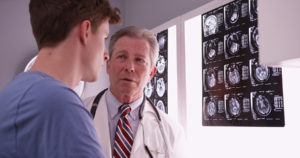Physical Activity for Mitigating Pediatric Post-Concussive Symptoms
A study published in the Journal of the American Medical Association (JAMA) found that children and adolescents who continued their physical activities within one week of an acute concussion had a lower risk of persistent post-concussive symptoms four weeks later compared to those who did not partake in physical activity (Owens, 2017).
 This study was a secondary analysis of the prospective, multicenter Predicting Persistent Postconcussive Problems in Pediatrics Study, which included 3,063 participants between the ages of 5 and 17 who presented to a pediatric emergency department (ED) due to an acute concussion between August 2013 and June 2015. After excluding patients who had brain imaging abnormalities, multisystem injuries requiring hospitalization, or did not complete all assessments of the study, the final analysis consisted of 2,413 participants. Patients were contacted at 7 and 28 days post-concussion to report on their physical activity levels and symptom severity. Activity levels were classified into four groups: no activity, light (walking, swimming), moderate (non-contact sport exercises like soccer drills), and full exercise (competitive, full-contact sports). The primary outcome measure was the presence of persistent post-concussive syndrome (PPCS), defined as a minimum of three new or worsening symptoms on the Post-Concussion Symptom Injury scale at day 28 compared with the participants’ pre-concussion status.
This study was a secondary analysis of the prospective, multicenter Predicting Persistent Postconcussive Problems in Pediatrics Study, which included 3,063 participants between the ages of 5 and 17 who presented to a pediatric emergency department (ED) due to an acute concussion between August 2013 and June 2015. After excluding patients who had brain imaging abnormalities, multisystem injuries requiring hospitalization, or did not complete all assessments of the study, the final analysis consisted of 2,413 participants. Patients were contacted at 7 and 28 days post-concussion to report on their physical activity levels and symptom severity. Activity levels were classified into four groups: no activity, light (walking, swimming), moderate (non-contact sport exercises like soccer drills), and full exercise (competitive, full-contact sports). The primary outcome measure was the presence of persistent post-concussive syndrome (PPCS), defined as a minimum of three new or worsening symptoms on the Post-Concussion Symptom Injury scale at day 28 compared with the participants’ pre-concussion status.
Based on an unadjusted analysis from this study, at 28 days post-concussion PPCS was present in 24 percent of participants who returned to physical activity within one week of their concussion, compared to 43.5 percent who were physically inactive during this same timeframe (Owens, 2017).
Pediatric Concussion Guidelines
The authors of this study suggested that current pediatric concussion guidelines may need to be reconsidered in light of these findings. Current guidelines advise for a period of rest from physical activity following a concussion until common post-concussive symptoms such as headache, fatigue, dizziness and irritability have settled. The study authors emphasize there is limited evidence demonstrating the effectiveness of these guidelines in promoting positive long-term outcomes. Additionally, they note that adherence to these guidelines may deprive young patients of the developmental and reparative health benefits of physical activity (Owens, 2017).
Despite the recovery benefits reported from this study, experts strongly caution against returning to high-risk physical activities immediately following a concussion, due to the heightened risk of further injury. Moreover, everyone responds differently to the symptoms of their injury, so they should evaluate how well they are handling them before resuming athletic activities.
Interested in learning more about Migraine research? Please call 561-845-0500. The Premiere Research Institute in West Palm Beach regularly conducts clinical research studies in the field of Migraines. To find out more about these studies click here or sign up for their newsletter to keep informed about the newest treatments, articles, and research that are being conducted in the field of Migraines.
References:
Grool AM, Aglipay M, Momoli F, et alfor the Pediatric Emergency Research Canada (PERC) Concussion Team. Association between early participation in physical activity following acute concussion and persistent postconcussive symptoms in children and adolescents http://jamanetwork.com/journals/jama/article-abstract/2593568. JAMA 2016; Epub 2016 Dec 20.
Owens, S. (2017). Early Return to Activity after Concussion May Reduce Post-concussive Symptoms in Youth. Neurology Today, 17(3), 1. doi:10.1097/01.nt.0000512941.15486.b2
Chrisman SPD, Rivara FP. Physical activity or rest after concussion in youth: Questions about timing and potential benefit http://jamanetwork.com/journals/jama/article-abstract/2593551. JAMA 2016; Epub 2016 Dec 20.
